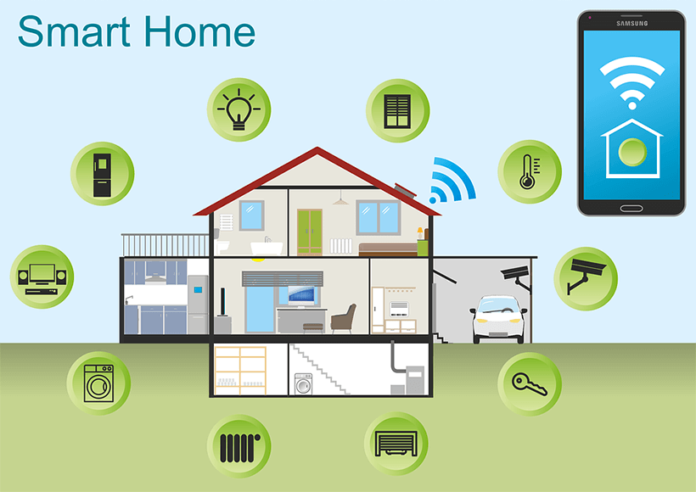You may have heard the IoT loosely described as ‘an array of edge sensor and actuator devices, connected via the Internet to cloud-based computing and analytics resources’. This description works well enough for the Big Picture – but zoom in more closely, and you’ll find that it’s sometimes not entirely accurate.
The issue lies with the IoT’s edge devices. There are very large numbers of them, and their population is growing rapidly. However, not all are connected directly to the Internet. It’s not always possible or even desirable to do so.
According to a Juniper report, the number of IoT-connected devices, sensors and actuators will reach over 46 billion in 2021; compared with a United States Census Bureau world population estimate of just over 7.7 billion for 2021, this equates to very nearly six devices per capita. These are large volumes and would represent a considerable number of internet connections if they were all connected to the Internet. However, as mentioned, not all IoT devices are directly connected. As we shall see, some devices, particularly small sensors, benefit from eliminating the overhead of a high-performance IP-based network. Additionally, the presence of an IP address increases a device’s vulnerability to hacking.
Other applications may be based in remote rural communities or otherwise out of reach, so no permanent reliable internet connection is available. Possibilities may be limited to collecting data into a logging device, then transporting it on a memory stick to a location where it can be analysed to generate meaningful information and recommendations for action. With the right technologies, however, long-distance communications can be achieved without the Internet or IP addresses being involved.
There are very many IoT devices operating without Internet connections in a variety of circumstances, such as:
- No Internet connection is available, so it’s not an option
- An array of sensors has characteristics unsuitable for direct connection to an IP-type Internet connection
- Security concerns related to the hacking of Internet devices
We’ll explore these issues by considering a set of Internet-free scenarios; we’ll highlight the problems that have arisen and the solutions that are being adopted in response. This will explain why the concept of ‘IoT without the Internet’ is an attractive prospect for many types of user.
Scenario #1: Remote village location
In a post entitled ‘IoT without the Internet?’ IoT blogger Dana Blouin describes a trip he took to Northern Thailand to support a volunteer IoT effort at a school that serves a rural hill tribe. The project was backed by three Thai startups; Knit by Jib, Drvr and Bangkok Bike Finder.
The school is extremely remote and took two days to reach from Chaingmai. It is also completely off the grid, with no power, Internet or mobile phone coverage. At least sunlight is plentiful, so any IoT devices can be solar – powered. The lack of communications can be managed too, by storing data on monitoring devices or mobile phones for later transmission to the Cloud for analysis.
One possible use for the IoT here relates to the ever-present challenge of maintaining adequate clean water supplies. Sensors could be used for the water tanks at the school to measure levels, letting the teacher know when they need to turn the valves on to fill the tanks, or possibly some sensors could check water quality.
Another possibility is an automatic watering system and soil moisture sensors to keep the school vegetable garden productive.
These are just some ideas of what could be done in a location like this with no Internet. Possibly the biggest benefit of such projects would be as learning experiences for the children.
Scenario #2: Home automation systems
A home automation system may contain video security cameras that require high-bandwidth communications to handle their video transmissions. However, there are many other devices that only transmit packets of data occasionally, and so don’t warrant high-bandwidth networking. Instead, they benefit from a low-bandwidth local network connection using standards such as ZigBee, BLE or ANT that don’t impose a heavy hardware, software or power consumption overhead.
This is especially important for devices that may be physically small, and dispersed to locations where providing an electrical mains supply is difficult or impossible. A high-performance network is not only unnecessary but would also impose an unwelcome burden in terms of size and power consumption. Reducing power consumption related to network activity can significantly extend the device’s battery life.
Home devices and applications that can benefit from lower-performance networks include:
- Fire/CO detection
- Leak/moisture detection
- Window & door open and close
- Video doorbell
- Smart thermostat
- Motion sensors
- Lighting control
While designers might be strongly motivated to design their sensors with a simple local network connection for the reasons above, there are also significant security-related benefits to using a port devoid of any IP address. This removes exposure to many types of cyber threat. Hackers may be able to activate or de-activate devices across a local area network, but won’t be able to access data.
In 2015, security firm Synack analysed 16 home automation devices from cameras to thermostats. Significantly, the researchers found themselves able to hack into almost every appliance. They described the state of security as ‘pretty atrocious’.
The exercise involved playing different attack scenarios, simulating situations that could expose users to hacking attacks. These included planting malware in products before they left the factory, and hijacking of mobile apps intended for remote control.
Synack found that connected cameras had the greatest number of security vulnerabilities, with devices tested found to have no data encryption, and weak passwords. Thermostats had serious security issues that could be exploited to control them; Home automation centres also had numerous flaws.
Problems arise because device designers are not security experts, and they are focused mainly on product innovation. They have a ship now and patch later mentality, and there is no industry standard, and no way to tell if a product is secure or not for the average user.
Another security firm, Veracode, conducted a survey with similarly disturbing findings; they showed how security breaches could lead to physical as well as financial violation. Authentication and arbitrary code execution flaws could be exploited to gain control of devices. By obtaining information related to the presence of people in a house, criminals could spot opportunities to commit a robbery. Villains could also violate privacy by manipulating microphones on connected home devices.
Researchers at ReVuln found that smart TVs and connected WiFi networks can create vulnerabilities. Criminals could access files within USB sticks plugged into the TV, or steal browser cookies containing sensitive information. Also, a hacker could spy on users by exploiting vulnerabilities in smart TVs and their connected LANs.
Other devices, including smart meters, smart thermostats and smart bulbs could also allow hackers to penetrate domestic networks.
The reality is that many home automation systems will comprise some devices on local networks, and others on WiFi or direct Internet connections. One solution could be something like NXP’s recently-introduced modular IoT gateway. Although designed for large node networks, it’s interesting because it supports a wide array of wireless communications protocols including Thread, ZigBee and WiFi. Built-in intelligence enables time-critical responses and operation even when cloud connectivity is not available.
The device employs robust encryption measures including encrypted wireless communications to prevent unauthorised access, as well as an interception, man-in-the-middle and replay attacks. It also uses AES encryption for Thread and ZigBee messages. This is important, to stop hackers from activating devices on these networks, although they will not be able to fully access data. Additionally, the gateway provides access to the advanced security capabilities of its i.MX applications processor.
Scenario #3: Thingstream networking
Swiss mobile communications software company Myriad Group has announced the commercial availability of Thingstream, a device connectivity network. Thingstream was developed after Myriad found an alternative use for Unstructured Supplementary Service Data or USSD. This messaging data is a protocol used by mobile phone networks to communicate with a service provider’s computers.
The network supports a range of IoT applications suited to devices in motion or remote locations, or that must be secure before connection to the cloud. Because USSD is a feature in all cellular networks, it can provide secure IoT connectivity without involving the Internet. Myriad claims simplicity as a strong selling point for the solution, with applications including asset tracking, logistics, facilities management, and environmental monitoring.
Thingstream avoids the need for cellular data and a roaming carrier partner; support for TCP/IP is no longer required. It allows small, secure payloads to be delivered to the cloud environment; while doing so, it reduces the processing and power consumption required by the transmitting device.
Myriad is also trialing Connect Hub, a platform-as-a-service (PaaS) offering.
Scenario #4: Industrial robots
The software that runs internet-connected robots is outdated and vulnerable to hacking, according to a new report from cybersecurity firm Trend Micro and the Politecnico de Milano.
Researchers found tens of thousands of industrial devices, including industrial robots, were susceptible to hackers. Obvious threats include safety functions being overridden, allowing robots to kill factory workers outright. However other, less immediately detectable threats also exist; these include introducing subtle defects that lead to field failures, things catching fire, safety systems failing, loss of structural integrity and more.
A Trend Micro paper entitled ‘Rogue Robots: Testing the limits of an industrial robot’s security’ details the diverse types of attack and consequences a network – connected robot could be subjected to.
One solution might be to run robots entirely without Internet connections, but this may be impractical for anything but the simplest of robots and tasks.
Another solution could be to build an IoT/robotic network within all or part of a factory that is disconnected from the Internet and the corporate network by a so-called “Air Gap”. However, it’s difficult to maintain the integrity of such an air gap, as it could be compromised in several ways:
- Need to exchange files
- Compromised personal devices
- Vulnerabilities and human error
- Insider Threat
- The threat of airborne attacks such as Blueborne, which can allow hackers to exploit Bluetooth connections to penetrate and take complete control of targeted devices. The attack does not require the targeted device to be paired to the attacker’s device or even to be set on discoverable mode
Accordingly, the Trend Micro paper makes some recommendations about how robot manufacturers and users can protect themselves against hacking attacks. Industrial robot standards must consider cybersecurity threats in the same way as ICS and automotive sector standards have evolved to mitigate them. Network defenders must fully understand the unique position that industrial robots have in terms of securing them.
However, robots have a very long lifetime, which means vendors must be able to provide security updates to all currently deployed versions, which they may not always be able to do. Furthermore, customers may be worried by downtimes or potential regressions carried by software updates and thus refrain from timely patching of their systems.
IoT Security Foundation
This article has shown how it’s possible to set up some IoT networks, or more often parts of IoT networks, without IP technology. However, the reality is that most IoT networks will in some areas depend on Internet-type communications, or be exposed to malicious or inadvertent network connections.
Accordingly, IoT designers, implementers and users should be mindful of network security risks and countermeasures. One possible starting point is the IoT Security Foundation, a non-profit organisation dedicated to driving security excellence. Here’s their view of the IoT security challenge:
“Along with the IoT opportunity comes the security challenge: With more and more devices becoming connected, the attack surface for adversaries is target-rich. What is considered secure today may not be tomorrow. A typical IoT system will rely on data and networks of variable provenance, devices may be expected to run on batteries for many years and new vulnerabilities are likely to be required to be patched in the field and at scale. Whilst we can learn lessons from the pc and mobile eras, IoT systems are breaking new ground and so are the security challenges. With more than just reputations at stake, it is imperative that technology providers, system adopters and users work together to ensure security is fit-for-purpose.”
Conclusion
In this article we have seen that not every IoT device is connected to the Internet; sometimes it isn’t possible, because no local Internet connection is available, but in many more situations a direct connection isn’t necessary or even desirable. The biggest benefit of eliminating such connections is to remove the visibility and hackability of an IP address. The more that IoT infrastructures influence our lives, the greater the threat and possible consequences – including physical – of any security breach.
Accordingly, resources like the IoT Security Foundation are an important part of the rapidly-growing IoT landscape. Developers everywhere should be encouraged and facilitated in designing security into their products from the outset, to effectively counteract the threats being identified.
The article is authored by Mr. Uma Pinagli – Business President, Element14.













